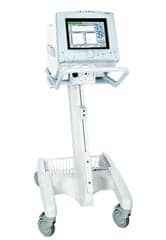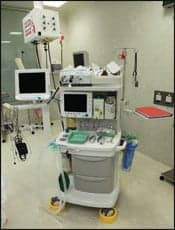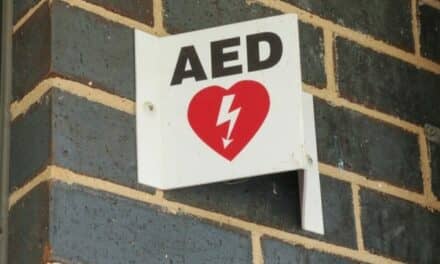 |
| Open-ended wording has led to confusion as hospitals struggle to identify “life support equipment.” |
Earlier this year at the AAMI conference in Baltimore during the Technical Iconoclast session, I presented my findings on the topic of what should be considered life support equipment in the context of The Joint Commission’s (TJC) current standards. Open-ended wording by the FDA and TJC has led to many wasted hours as health care professionals struggle to identify for their individual hospitals what constitutes “life support equipment.” Since that time, what I presented has continued to generate discussion among members of the clinical/biomedical engineering community. The key part of what I presented is the idea of creating a task force of recognized experts to develop a prescriptive list of equipment that all hospitals could choose to use instead of having to develop their own list based on an analysis of the generally worded definitions published by the FDA and TJC. The result would be more consistency and increased patient safety.
One possible option for identifying what equipment should be considered high priority for PM completion—what TJC has labeled as Life Support equipment—is to create an analysis-based prescriptive list of such devices. This would help to reduce the confusion caused by the FDA and TJC having different definitions of “life support” or “life-sustaining” equipment.
Yadin David, PE, CCE, EdD, principal, Biomedical Engineering Foundation LLC, Houston, suggests that this article/topic should be critical reading for every practicing clinical engineering professional.
“There is a need to understand and quantify the issue as it is directly related to risk mitigation and patient safety,” David says. “Secondly, it impacts the strategy of future equipment management programs. The maintenance program in the aviation industry is built on strong collaboration between manufacturers, regulators, users, and service providers. It is based on industry recommendations and lessons learned from professional investigation performed when adverse events occurred. Because it is based on experimental and industry data, it is a pinpointed maintenance program that delivers the desired safe operation.”
The History of the Debate
How did this debate come about? Prior to 2004, TJC had a mandatory PM completion requirement of 95% for all of the facility’s medical equipment. Concern arose that hospitals could meet this requirement without completing PMs on a substantial portion of their more critical equipment, creating what TJC saw as a potential threat to good patient care. As a result, in 2004, TJC modified its standard EC.6.20 (as of 2009; EC.02.04.03 EP 2, EP3) by dividing medical devices into two separate classifications: Life Support and Non-Life Support. Devices identified as Life Support were required to meet a higher standard (a 100% PM completion rate) than the devices identified as Non-Life Support.
To further elevate the importance of meeting the higher completion rate, TJC designated the requirement for the Life Support devices to be scored as a Category A requirement. The requirement for Non-Life Support devices was to be scored as a Category C requirement. This requires only a 90% or better PM completion for the best score. To add to the confusion, it should be noted that you will not find either of the PM completion thresholds for the best scores cited directly in TJC’s Hospital Accreditation Standards (HAS) manual. The thresholds have to be interpreted from the implications built into the TJC’s scoring method as it is explained in the HAS manual.
The FDA’s definition of “life-supporting devices” is found in 21CFR-860.3 (3) (e), which relates to their Class III premarket approval process. What’s problematic here is that the FDA definition was coined for a different purpose; it is not intended to address a device’s sensitivity to on-time PM completion.
In hospitals across the country, the sometimes-divisive discussion continues unabated regarding which medical devices should be identified and maintained as Life Support equipment. TJC’s current standards require that each hospital create its own list of what it deems to be Life Support devices and to include, at a minimum, the partial list of Life Support equipment specifically identified by TJC. This partial list includes ventilators, anesthesia machines, and heart-lung machines. Recently, defibrillators were added to this list. George Mills, director of the Standards and Interpretation Group for TJC, announced this at AAMI’s conference this year, stating that the decision for this addition was based on the recommendation of a multidiscipline group within TJC.
 |
| The Joint Commission has identified a partial list of Life Support equipment that includes ventilators, anesthesia machines, and heart-lung machines.” |
Open Interpretation
The FDA’s definition of Life Support devices states that Life Support devices are those devices that are “essential to, or that yield information essential to, the restoration of a body function important to the continuation of human life.” On the other hand, TJC defines a Life Support device as “any device used for the purpose of sustaining life and whose failure to perform its primary function, when used according to manufacturers’ instructions and clinical protocol, will lead to patient death in the absence of immediate intervention.”
Although these definitions of Life Support devices appear very similar in their intent, they do differ somewhat in their specific language. In addition to this varying language, the open-ended quality of the phraseology of each leaves a great deal of room for individual interpretation, as well as the potential for time-consuming and counterproductive confusion, conflict, and contentious debate. The health care professionals (biomedical/clinical engineers and technicians, hospital clinicians, risk managers, and hospital administrators) tasked with drawing up the complete list for their individual hospitals earnestly wish to comply with these regulations and standards, but simply need more guidance. A smaller hospital with fewer resources faces a more difficult task and probably requires more help.
Additionally, health care providers consider many medical devices used in the treatment and care of patients “critical devices.” As a result, equipment designated as Life Support frequently become a subset in a much larger grouping of devices that clinicians, through their own priorities, often feel should be added to the Life Support category.
The national furor over this issue is underscored by the number of biomedical and clinical engineering blogs flogging the subject often on a daily basis as technicians and engineers work feverishly to perfect “the list.” To further complicate the issue, one blogger reported that a hospital administrator told his biomedical technician, “If I don’t see it in print [presumably from the FDA or TJC], we’re not going to follow it.” This may be a more prevalent attitude than is readily acknowledged and would also have an unfortunately adverse effect on the creation of the “perfect” list of Life Support devices in any given hospital.
“Some large health care organizations have created such a list, while some still struggle,” says Paul Sherman, CCE, senior biomedical engineer, VA Center for Engineering and Occupational Safety and Health, St Louis. “If those who have succeeded with a systemwide list would be willing to share their process and results, it would speed the process up as well.”
One ancillary, but still problematic, complication of this create-your-own-life-support-device list policy is the sheer variety of lists that may finally pervade a health care system striving to become ever more unified in its commitment to providing the best possible health care. As technical and clinical staff members move from facility to facility throughout the health care system, they will each require in-service education on the new facility’s particular list on their new hospital’s specific Life Support list. Here is another possible opening for confusion, misunderstanding, and/or error in the pursuit of quality health care as a result of these unfortunate ambiguities.
One possible solution to this ongoing conundrum is the creation of a prescriptive list of equipment that should be given the higher priority for PM completion; a thoughtful extension of TJC’s basic list. Each hospital would then retain the existing option to subscribe to its own hospital-approved list of Life Support devices (to be used expressly for defining which devices are to be given higher priority for PM completion), or opt to follow the task force’s prescriptive list in lieu of struggling to create its own list from scratch. A specially designated task force would develop the prescriptive list using recognized analytical tools, such as failure mode and effects analysis.
 |
| The Joint Commission recently added defibrillators to its partial list of Life Support equipment. |
List Requirements
“In order to be effective, the list of Life Support devices must have some basic features,” Sherman says. Among these features he suggests are:
- It must be easily defendable, both to local Environment of Care commit- tees, risk management offices, local/ state authorities having jurisdiction, and, of course, TJC;
- The equipment must benefit from pre- ventive maintenance. Alternatively, TJC surveyors will need to know that some equipment on the list will fall under the alternate PM strategies— run to fail, for instance;
- Arguments against any definitive list will need to be addressed; and
- The FDA’s Class III devices may pro- vide a basis to build the Life Support list. That information is at the product classification page on the FDA Web site. From that, there are 404 Class III devices and 25 Class III (513(f (1)) devices. Informally reviewing those devices reveals approximately 60 devices that may benefit from maintenance inspections.
“Another source, the FDA’s Safe Medical Devices Act tracking requirements, include primarily implants and devices that don’t benefit from maintenance,” Sherman says. “On that list, only a few items may qualify for inclusion under The Joint Commission requirements.” According to Sherman, those items are:
- Breathing frequency monitors;
- Continuous ventilators;
- Ventricular bypass (assist) devices; and
- DC-defibrillators and pad- dles.
“The above devices are specifically listed for use outside the hospital,” Sherman says. “The two groups left are subgroups on infusion pumps: infusion pumps designated and labeled for use exclusively for fluids with low potential risks, such as enteral feeding and anti-infectives; and electromechanical infusion pumps. Neither of these devices are on The Joint Commission’s list.”
Keeping the Proposed Task Force Initiative Alive
If the clinical engineering community is supportive of this proposal, the next step we need to consider is to approach the professional organizations suggested by Paul Sherman. The goal should be to have each of the mentioned organizations appoint a representative to the newly formed task force, allowing them to begin the work of scoping the project and identifying time lines and resource requirements.
Yadin David has discussed the direct impact that this project has on risk mitigation and patient safety. The work performed and the information generated from the proposed task force could be one modular component to an even greater project that David appears to be suggesting. What we must attempt to avoid is waiting by the sidelines for someone other than ourselves to make the next move. Let’s engage our professional community to be proactive in moving forward with this proposal. I am encouraged in that I already have a few individuals who have expressed interest in being part of a steering committee and will soon begin the process of contacting the professional groups identified. If readers have suggestions or concerns regarding this proposal, I believe that 24×7 is a great forum to express their thoughts and I would look forward to reading them.
—LA
“To serve this important issue adequately, the notion of creating a special task force inclusive of equipment owners, users, manufacturers, regulators, clinicians, and service providers is very much on target,” David says. “Through such an effort, clinical engineering professionals will have the unique opportunity to make recommendations based on accumulated knowledge and experience and to make the point-of-care environment safer and more efficient. This is just what we aim to accomplish every day of our practice. We do not wish to stand still and watch others, with good intentions, mold our practice while creating a wasteful effort. Such an example would be the many years of collecting leakage current values and building paper files. Therefore, we need to find a way to share adverse events data that relates to PM or the lack of such and analyze (quantify) its relationship to safer patient care.”
“Task force membership should represent industry groups that have a demonstrated experience in addressing patient safety issues,” Sherman says. “Some groups I believe should be considered include professional organizations such as AAMI, AHTF, ASHE, and META; OEMs and vendors; and major health care provider systems such as Kaiser Permanente, the Department of Veterans Affairs, and university systems.
“Conversely, after suggesting these members, there is a compelling argument for keeping the work group as small as possible,” Sherman continues. “Ten individuals maximum, perhaps fewer. Many individuals representing these groups may already participate through their affiliation and participation within the professional organizations mentioned.”
Addressing a time frame, Sherman says, “The need for the development of a Life Support list is immediate; waiting for a large group to come to consensus may delay the list beyond usefulness. One concern is whether The Joint Commission plans to keep this standard for the foreseeable future. There’s no point in spending a lot of time and effort coming up with the list of equipment if TJC intends to modify or replace the standard in the next 2 to 3 years.”
We need to recognize the increasingly limited availability of resources—time, money, and staff—and find better ways to use what we do have more effectively. The creation of a recognized national task force to develop this analytically based consensus prescriptive list of Life Support equipment utilizing accepted testing methods, such as FMEA, will help free up some of those precious resources for other critical tasks.
“This presents important data to analyze and determine what—if any—failed during a PM procedure, therefore providing a quantifiable tool to logically modify PM assignments based on specific user/institutional experience,” David says. “If PM programs can reduce equipment failures that contribute to delays, injuries, or use errors in the management of patients, the program must be planned well and executed with a 100% commitment—a 90% or 95% commitment is not acceptable. Equipment having parts susceptible to wear and tear must have a maintenance program that ensures safe, reliable risk mitigation. There are different approaches in achieving this goal. For instance, when equipment maintainers receive clear training on identifying these key characteristics of a medical device, the frequency of service can be modified. However, when equipment maintainers do not recognize such conditions, the frequency and intensity of PM should match the potential risk presented by the device.”
|
Would a prescriptive list help you? Blog about it with us. |
“As Malcolm Ridgway and Binseng Wang have discovered in their attempts to inspire reliability centered maintenance (RCM) in our industry, it is a challenge to get the groups to cooperate,” Sherman says. “But, as in the Boeing 747 model that inspired RCM, it can be a win-win for all parties, including the manufacturers, resulting in more appropriate work, higher reliability, and lower liability.”
If we are truly committed to the ideal of providing the safest patient environment, we need to rethink some of our existing processes and approaches and consider testing new ideas. Those new ideas may not always be a perfect fit, but we are certain to learn from them and we can make any necessary corrections or adjustments along the way.
Leslie R. Atles, CCE, CBET, is the director of technology management at Masterplan, Chatsworth, Calif. For more information, contact .
Recommended Reading
Medical Device Tracking; Guidance for Industry and FDA Staff: August 15, 2008 www.fda.gov/MedicalDevices/DeviceRegulationandGuidance~. Accessed September 17, 2009.
The FDA’s Class III devices may provide a basis to build the Life Support list. That information is at the product classification page on the FDA Web site. www.accessdata.fda.gov/scripts~. Accessed September 17, 2009.





